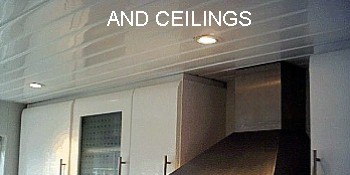
Kitchen wall cladding panels are perfect for those looking for an easy life.
They provide a hygienic, wipe-over surface that is easy to clean. Kitchen ceilings can also be a demanding area but there are panel solutions available for these too.


Any room can suffer adversely from mould problems. Room that experience a lot of condensation are obviously affected the most.
Modern double glazing ensures homes are virtually airtight. Many homes also lack any form of extraction. This means that condensation has nowhere to go and will settle on cold surfaces.
Tiles have a cold surface and will attract condensation. The moisture on the tiles spreads to the grout. This will be the first place to show visible signs of mould. So an alternative wall covering can be used to try and circumvent this problem.
This is where kitchen wall cladding panels come into their own.
Kitchen wall cladding has no grout to turn mouldy. This makes it a very hygienic wall covering. Many commercial kitchens use a variation on this product to eliminate the need for grout. Large sheets of PVC are used to line the walls providing a one-piece solution. With cladding, the wall is covered with separate planks of the material that slot together. This makes them easier to install and provides more choice when it comes to decorative finishes.
The smooth, wipe-over surface is ideal for the demanding conditions found in all kitchens. Grout is always the weak spot of any tiled wall. And it makes cleaning so much harder.
What Cladding Designs Work Best In Kitchens?
All cladding can be used in kitchens but some designs work better than others. The kitchen unit design will have the biggest effect on what colour you choose. The kitchen worktops also need to be factored in.
Wood effect units will suit a plain or light marble effect design. You need to try and avoid using too many patterns. Two would usually be ideal. Three might be too much unless two out of the three patterns are very similar.
So if your units are wood, your worktop is a stone design then a plain wall covering works best. If your units are white, your worktop granite you could get away with a patterned design for the cladding.


How Much Cladding Will I Need?
Usually not that much. Kitchens are usually slightly larger than bathrooms but the amount of cladding required is usually less.
Even though a kitchen might be quite large, a great deal of the surface area of the walls is taken up with cupboards. So, the actual area that needs to be covered can be quite small. We would recommend that you install the wall cladding after the kitchen units have been fitted. This minimises the number of panels required. With bathroom wall cladding however, you would normally fit the fixtures (such as basins and toilets) first.
This is not a hard and fast rule but is the standard way of fitting cladding. The panels are not structural so ideally you do not want to fix items to them. And kitchen units have straight edges making cutting relatively easy.
If, for some reason, you have curved items in the kitchen then it might be better to fit the cladding first. Cutting the panels to follow a curve is not easy. It can be done but requires experience and more advanced cutting skills.
Cladding Limitations
Cladding is made from PVC so it has limits with regards to the amount of heat it can deal with. Most are suitable for use up to 60° but check with your manufacturer as this can vary.
The oven is the obvious place in a kitchen that generates heat. The oven itself is not really an issue as it will usually be housed inside a wooden unit. Kitchen wall cladding panels might not be the best material to use behind a stand alone oven.
A bigger problem is the hob. Open flames from a gas bob can spread around a pan and generate a lot of localised heat. We would recommend a stainless steel splashback in this area. Some glass splashbacks may be suitable. But check with the manufacturer as many are not designed to handle high temperatures.
If it could be used behind a hob the cladding would be the perfect product for kitchen walls. But this is its only real shortcoming and this can be easily overcome with and alternative covering for this area. Glass and stainless steel splashbacks look good. They are also tough and have the same easy-clean properties that cladding enjoys.
Kitchen Ceilings Can Also Be Panelled
As well as cladding the wall areas the panels are also perfectly suitable for use on the ceiling, which will give you yet another area that you will not have to worry about for years to come – once these panels are up, they look good and stay looking good. And of course it is in bathrooms where cladding really excels and its waterproof qualities come to the fore.


